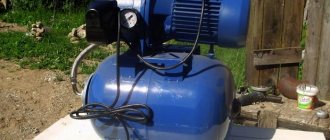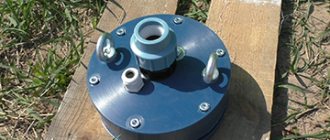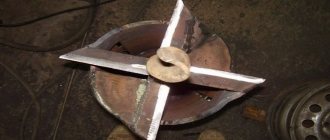Piston pump
The most common device for manually drawing water from a well is a piston pump. Such designs can be seen in many private courtyards and summer cottages. They are distinguished by a variety of designs of the above-ground part, but the structure of the mechanism and the operating principle are the same.
Device
To understand how a hand pump works, you need to understand its design. It can be divided into underground and aboveground parts:
- the visible part of the unit is located above the ground. You should immediately highlight the main part – the cylindrical body. It can be made of cast iron, stainless steel or ordinary metal pipe. A water spout is attached to the side wall of the housing. It can be made from similar metals. Some craftsmen make their own plastic spout. A rod emerges from the top of the body, connected by a hinge mechanism to a handle for pumping water - a rocker arm;
- the second, invisible part of the pump is located inside the well casing. First of all, this is a working cylinder connected by a metal pipe to the above-ground part of the unit. Inside the cylinder there is a piston with o-rings, which is connected by a rod to a rocker arm. The piston itself has one or more holes at the end, closed by valves. The bottom of the cylinder is equipped with a pipe to which a pipe is connected that supplies water from the well.
Piston-type hand pumps must have a check valve at the end of the supply pipe. This is due to the fact that the working cylinder, located inside the casing, is not immersed in water.
Operating principle of the unit
To understand the principle of operation of the piston mechanism, let's look at it step by step:
- In the initial position, the rocker arm is lowered down. In this case, the piston inside the cylinder is located in its upper part. The O-rings fit tightly against the cylinder walls, and the valves on the piston are closed, so water is retained inside. The check valve at the end of the supply pipe is also closed, allowing the water column to remain in place. If you look inside the above-ground housing, you can see that the water is at the same level as the spout. In order for it to start flowing out through the spout, the water must be raised.
- Lifting the rocker up, the rod pushes the piston down. During movement, pressure is created inside the cylinder. It presses the check valve, preventing water from flowing out of the supply pipe, and at the same time opens the valves on the piston. Through the holes, water enters the space above the piston of the cylinder.
- With the next movement, the person lowers the rocker arm down, while the piston itself rises. The valves close and the pressure pushes the water up, which flows out through the spout.
- Simultaneously with the rise of the piston, a vacuum is created underneath it inside the cylinder. It opens the check valve, sucking in a new portion of water.
Further actions when moving the rocker are repeated, which allows you to collect the required amount of water.
Manual piston pumps are capable of lifting a column of water from a depth of up to 10 m. Their performance depends on the size of the cylinder and the height of the piston. Typically, one movement of the rocker can draw up to 2 liters of water. The disadvantage of the design is the rapid wear of the sealing rings, especially if sand impurities are encountered. In winter, such a unit cannot be used either, since the cylinder is close to the surface of the earth, and the water inside will simply freeze.
Recommendations for choosing a hand pump
When choosing a hand pump, you must first focus on the depth of the well. If it is from 5 to 7 meters, all types of portable pump-action devices will cope with the task. For sources where the water surface is at a height of up to 10 meters, any lever equipment is suitable, except for vane ones.
Only a hand-held rod device can lift liquid to the surface from a depth of up to 30 meters. But for this, the well should not have bevels or bends.
Hand-held devices of all types work correctly with wells with a diameter of 4 inches or more. The user selects and installs the model that appeals to him visually and is affordable.
The weight of lever equipment ranges from 4 to 130 kg. This parameter is important at the time of transportation. Light products up to 15 kg can be delivered to the installation site yourself. Heavier models will have to be transported by car and hired workers will be used for loading/unloading.
Problems often arise when installing heavy hand pumps. Typically, the owner requires outside assistance when carrying and installing the device. It is advisable to think about this in advance and invite a master or use the services of one of your relatives, friends or acquaintances.
Another important element when choosing a model is water quality. Vane units are very demanding in this regard and cannot cope with pumping liquids containing sand and impurities.
If there is a problem with water purity at the site, you should prefer piston, rod or diaphragm type pumps. They will perform the task normally and will not fail after small abrasive particles pass through the system.
Do you need a functional pump to pump out dirty water, but a manual option is not suitable? We recommend that you familiarize yourself with the best automatic models on the market and the selection rules.
If the equipment is needed only for operation in the summer, it is worth considering pumps with a plastic body. They are sold at a lower price, weigh little and are considered a budget option. But they cannot withstand serious workloads and often fail without working even for one season.
Products made from thin-walled food grade steel are considered more durable than plastic ones. Cast iron and bronze appliances have the longest service life. Their high price is compensated by a long operating period, reliability and resistance to environmental influences. All metal units are suitable for year-round use.
The appearance of the pump also matters. It is desirable that it be harmoniously combined with all other elements on the site and not spoil the surrounding landscape. Some manufacturers produce hand pumps with attractive handles and stylish taps. Such products are more expensive, but fully justify the cost, turning from a familiar element into a decorative object.
When there are several sources of water on the site, it makes sense to buy a pump that is as light and easy to carry as possible. It can be installed where liquid is required at a certain moment, and then moved to another point
In order for the pump to always work correctly and not break down, you need to take care of it, clean the individual components and lubricate them with special products. Some models have a self-cleaning system. Such devices do not require additional maintenance.
If you plan to spend a lot of time at the dacha, then you cannot do without automation of the water supply system. In this case, we recommend that you familiarize yourself with the rating of pumping stations that are in demand among buyers and the rules for choosing the best one.
Rod pump
This manual unit is also called a rod unit, although its design and operation are identical to the piston unit. The only difference is the location of the cylinder. Here it is immersed in water at least 1 m below the mirror. This makes it possible to lift water from a depth of 10 to 30 m.
Such units require the installation of a well casing pipe with a diameter of at least 100 mm. The working cylinder is connected to the above-ground part by a long metal pipe and a rod of the same size. This increases the weight of the entire structure, which complicates maintenance. Naturally, lifting a large column of water will require maximum effort. A do-it-yourself longer rocker helps to simplify the process.
The main advantage of the manual rod design is the possibility of winter use. And to prevent the water from freezing in the body of the above-ground part, the owners adapted to make a safety drain on the supply pipe with their own hands. To do this, a small hole is drilled in the supply pipe below 2 m from the ground level. During pumping, water will simultaneously flow through the spout and flow out of the drilled hole. After pumping stops, the remaining water from the upper part will flow into the well to the level of the hole. This way, the remaining empty above-ground part will not defrost in the cold.
Other types of hand pumps
The considered piston-type hand pumps are often made by hand for a home well. But they are not limited to the variety of such units. There are other types produced in factories.
Impeller unit
Such hand pumps are used in warehouses to pump liquid from containers. But it can also be suitable for a shallow well, where the water surface is no further than 7 m. The design consists of a metal body with an inlet and outlet pipe. An impeller with valves is installed inside the housing. Through an axis from the outside it is connected to the handle. The body itself is divided into two chambers by a jumper, on which there are also valves.
The operating principle is simple. To draw water from a well, simply lower a hose connected to the inlet pipe of the unit. By turning the handle, the impeller is set in motion, creating alternating areas of rarefaction inside the chambers. The valve groups are placed in such a way that they supply water only to the outlet pipe.
Membrane type unit
Another type of hand pump is a diaphragm pump, which has a similar appearance: a metal or plastic body with a handle for pumping. Only inside the housing, instead of an impeller, there is a membrane connected by a rod to a handle. It divides the housing into an upper air chamber and a lower water chamber. Inlet and outlet pipes with valves come out of the water chamber.
Lowering the handle downwards raises the membrane with the rod. The created vacuum opens the inlet valve, and water from the well enters the lower chamber. By lifting the handle up, the membrane moves down, creating water pressure. This causes the intake valve to close and the exhaust valve to open at the same time. Under pressure, the water can only escape through the outlet pipe.
Types of hand pumps
Manual water pumping equipment on the market is presented in a wide variety of options.
Well owners are offered the following types of products:
- winged;
- piston;
- rod;
- membrane
Each type has features that determine the area of maximum effective use. Regardless of the design and operating principle, all devices demonstrate approximately the same performance.
Plastic pumps are not very durable. When exposed to sunlight or sudden temperature changes, the casing may crack and burst. The equipment will have to be changed quickly, and this is an inevitable material cost
In one full cycle of reciprocating motion, about a liter of liquid will be obtained from the well. In a minute, you can collect from 20 to 40 liters of water in this way. A more accurate figure depends on how often the user can raise/lower the handle lever.
Type #1 - wing units
A manual vane pump is a compact device for pumping water from underground sources 5-7 meters deep . Its small dimensions make it possible to use the device for technical purposes in factories, warehouses, bases and other areas where it is not possible to install more powerful and larger equipment.
Structurally, the product consists of a housing with pressure and suction pipes. The impeller with blades is fixed on a shaft firmly connected to the handle of the device. The upper compartment of the device maintains a constant volume even if the position of the impeller changes.
The lower part of the pump working chamber is divided into two parts by special jumpers. Two valves are located on the pump blades, and two more, working in opposition to them, are located at the entrance to the lower chamber.
The pipes are connected to the metal body by means of a flange or coupling. Through the suction outlet, water from the well enters the system. The pressure part is connected to the disassembly point
When the user acts on the handle, the impeller begins to rotate. Alternating zones of high pressure and discharge are formed in the working chamber. The liquid is sucked in through the inlet pipe and vigorously pushed out through the pressure pipe. Pump valves ensure that water moves along communication lines in only one direction.
Vane-type hand pumps cope with pumping fairly viscous liquids, but do not tolerate contaminated liquids well. Not suitable for transporting water containing fragments of liquid fuel, alcohols, paraffin, edible oils and any abrasive materials. Work well with clean, shallow wells.
They can often be used in basements where it is not possible to place more powerful and bulky equipment. At a budget price they are sold in an anodized metal case.
Bronze products are more expensive, but are distinguished by exceptional corrosion resistance, do not lose their physical characteristics during operation and are not subject to deformation under the influence of pumped liquids
, the German K1 and K2 with brass valves and blades are popular The Russian analogue RK2 is sold at a higher price, but is equipped with a wing mechanism made of metal that is prone to corrosion.
Advantages of vane pumps: compact dimensions, ability to pump viscous liquids.
Disadvantages: low productivity, high demands on water purity, work in shallow wells.
Type #2 - piston type pumps
Piston devices are widely popular. Structurally, they consist of a cylindrical body made of food grade stainless steel. A piston moves inside, secured by a rod to a rocker arm.
Elastic fluoroplastic seals ensure a tight fit of the piston disc to the walls. Spherical check valves are located on top.
These types of pumps create inlet pressure. Placed 1 meter above ground level. They are mounted on the upper part of the casing communications in such a way that the check valve of the system is located at the outlet of the water-lifting pipe immersed in the hole.
Used where the water surface is high. Water is obtained from wells up to 10 meters deep. They cannot bring liquid to the surface from deeper sources. Great physical effort is not required to press the lever mechanism.
As the piston moves forward, the valve lowers and prevents fluid from flowing in the opposite direction. Water under pressure opens the built-in valves and rises above the surface of the piston disc.
Over time, pump seals and gaskets wear out and do not provide the required level of tightness. This significantly reduces equipment performance. To avoid such a situation, the device must be serviced and faulty components replaced.
During the reciprocating movement of the piston, the valve lowers and prevents the outflow of liquid in the opposite direction. Water under pressure opens the built-in valves and rises above the surface of the piston disc. During the return stroke, the disc valves close, preventing water from flowing down.
The air pumped into the system pushes the liquid under pressure upward and, as a result, it pours out through the pump outlet pipe.
In the ranking of the best-selling piston models, the top positions are occupied by steel devices with galvanized bolts from the Russian manufacturer Watergood . Products of foreign brands are less popular.
Advantages of piston pumps: pumping both clean and muddy water with sand, suitability for working with light petroleum products, acids, solvents, alcohols.
Another advantage is the simplicity of the design - for example, a piston-type pump can be made at home.
Main disadvantages: some models require insulation for the winter, as they cannot be used if the ambient temperature drops below +1 °C. Typically, this information is indicated on the manufacturer’s website and in the accompanying technical documentation of the device.
Type #3 - rod (rod) devices
Rod hand pumps are sometimes called rod pumps. They are used where water lies at a depth of 12-30 meters. For all other manual models, this is an impossible task.
The design of the devices is somewhat similar to piston units. The main working unit here is a cylinder and a piston with an elongated end. The pump part of the device is located in the aquifer.
It is important that the bottom valve of the rod pump is always in water. During the installation process, it is necessary to take this point into account and make sure that during pumping the structure does not end up above the actual level of the water surface
Rod-type equipment is mounted directly into the well. The rod part is immersed in water to a depth of about 1 meter.
Pumping of water begins when a person operates a lever device. The piston moves down and the bottom valve closes. The resulting pressure opens the upper valve and the liquid moves into the space above the cylinder.
During the process of lifting the piston element, water closes the upper valve, and the vacuum created under the piston opens the lower valve to suck in water.
An indispensable condition for installing rod-type equipment is an absolutely straight vertical well shaft without bends. The use of such devices on sloping terrain is unacceptable.
It is most important to use rod pumps in conditions where the water is too deep to install an external electrical appliance, the diameter of the well does not allow the installation of an automatic pump, or there is no possibility of connecting to the electrical network. In all other situations, spending money on equipment is not practical.
The main advantage of sucker rod pumps is lifting liquid from great depths. A compact rod-type pump for a well up to 15 m deep can be made at home. We recommend that you read the detailed instructions for making homemade pumps from scrap materials.
The disadvantages of purchased models are the complexity of installation, cumbersome design, large efforts required for pumping, the inability to use the unit in wells located on slopes or with internal curvature, and a high risk of rod breakage.
Type #4 - membrane equipment
Manual diaphragm or diaphragm pumps are very durable. They can pump clean/contaminated household water and diesel fuel containing impurities with equal success. Even if there are a large number of small particles of sand and abrasive elements in the liquid, all components work flawlessly.
Ball valves do not occupy a fixed place, do not rub against each other, but constantly roll. This promotes self-cleaning and reduces the risk of jamming to zero.
The working position of the membrane unit is vertical, with the handle down. The device is attached to the wall through narrowed parts on the sides of the housing. There is a pressure pipe at the top and a suction element at the bottom. If the integrity of the membrane is damaged, it must be replaced
The round body of the devices is made of durable plastic or cast from high-quality cast iron. Diaphragms and valves are made from oil and petrol resistant rubber. The equipment lasts for years and does not fail. Suitable for use only in shallow wells.
The device can be used not only for pumping water of any quality, but also for draining waste or rainwater from cellars, basements, trenches and other areas subject to flooding.
the Danish concern Grundfos and Taiwanese Ampika pumps are in demand among buyers . They are sold at the best price.
Among the advantages are wear resistance, undemanding quality of pumped water, optimal weight, reasonable cost, durability.
The main disadvantage is the ability to work in shallow wells (up to 6 meters).
Making your own hand pump
For home wells, the use of piston units is common. They are made by hand. But it requires a lot of turning and welding work. For clarity, let's look at the whole process step by step:
- The first step is to make a working cylinder. You won’t be able to do this with your own hands without the help of a turner. For the cylinder, take a stainless pipe 800 mm long. Its diameter is selected to be at least 80 mm, but you need to make sure that it fits inside the well casing. The inner surface of the pipe is turned on a lathe, giving it smoothness. Internal threads are cut at both ends. The adapter bushings for the pipe will be screwed in here.
- Often, instead of stainless steel, old cylinders from excavator hydraulics are used. The internal smooth walls do not require grooving, and original cuffs can be used as piston sealing rings.
- The piston itself can be made with your own hands. The simplest and most effective design is two round metal washers of slightly smaller diameter from the internal section of the cylinder. A hole with a diameter of about 30–50 mm is drilled in the center. Two holes with a diameter of 5–6 mm are drilled near it and a thread is cut inside with a tap. Now all that remains is to cut off a piece of elastic rubber and bolt it to the washer so that it covers the central hole but moves freely. This will be the valve.
- Holes with a diameter of 10 mm are drilled along the edges of the washers, relative to each other. A rubber cuff is inserted between the washers, clamping it with nuts screwed onto two studs 70 mm long. A jumper made of a thick plate with a central hole is screwed on top of the studs with nuts.
- Threads are cut at the ends of a rod 12 mm thick. One end is fixed with nuts to the piston bridge, the other end of the resulting rod will be fixed to the rocker arm. Before fixing the rod, do not forget to put the adapter sleeve on it.
- Next, the entire structure is assembled with your own hands. The piston is inserted into the cylinder by tightening the adapter sleeve that is placed on the rod in advance. The same bushing is screwed into the other side of the cylinder.
- A supply pipe with a check valve at the end is connected to the adapter down from the cylinder. A threaded metal pipe is placed on top of the rod and screwed to the upper adapter of the cylinder. The finished structure is lowered into the well. In order for it to be held on the casing, a stopper will need to be welded.
- Finally, you need to attach the glass with spout to the pipe with a flange or threaded connection. A metal stand is concreted next to the well. An axle is welded on top on bearings, and a rocker arm is attached to it. Now all that remains is to connect the end of the rocker arm with the rod protruding from the glass and the hand pump is ready.
As you can see, the design diagram is quite simple for making it yourself.
Some details do not need to be as described above. For example, the cylinder filling is often made from an automobile aluminum piston, where the valve is not rubber, but a ball from a large bearing. There are many options. The main thing is that the hand pump works efficiently. In contact with











